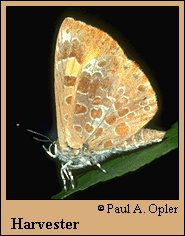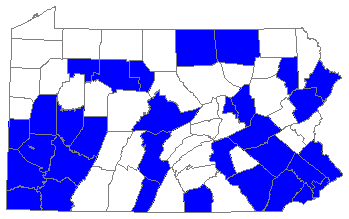 |
 

 |



Harvester (Feniseca tarquinius [Fabricius])
Wing span: 1 1/8 - 1 1/4 inches (3 - 3.2 cm).
Identification: Upperside has black spots and orange-brown areas surrounded by black. Underside hindwing is orange-brown to orange-purple with small, faint white circles.
Life history: Males perch in sunlight on the edge of leaves, watching for females, then fly back and forth in the area, returning to where they started. Females lay eggs in colonies of woolly aphids and sometimes scale insects or treehoppers because caterpillars are carnivorous on these insects. For protection from ants, some caterpillars feed under a silken mat covered with aphid carcasses.
Flight: Two flights in the north from May-August; three in the south from February-September.
Caterpillar hosts: Woolly aphids (Neoprociphilus, Pemphigus, Prociphilus, and Schizoneura) and sometimes scale insects or treehoppers; these insects suck sap from alders, witch hazel, ash, beech, hawthorn, and wild currant.
Adult food: Adult's short proboscis is suited for feeding on aphid honeydew; they do not sip flower nectar.
Habitat: Deciduous or mixed woodlands along streams.
Range: Eastern United States west to Minnesota, south to central Texas and central Florida.
Comments: Only North American butterfly species with carnivorous caterpillars.
Conservation: Not normally required.
The Nature Conservancy Global Rank: G4 - Apparently secure globally, though it might be quite rare in parts of its range, especially at the periphery.
Management needs: None reported.
References:
Opler, P. A. and G. O. Krizek. 1984. Butterflies east of the Great Plains. Johns
Hopkins University Press, Baltimore. 294 pages, 54 color plates.
Opler, P. A. and V. Malikul. 1992. A field guide to eastern butterflies. Peterson
field guide #4. Houghton-Mifflin Co., Boston. 396 pages, 48 color plates.
Scott, J. A. 1986. The butterflies of North America. Stanford University Press,
Stanford, Calif. 583 pages, 64 color plates.
Author: Jane M. Struttmann
State and Regional References:
Glassberg, J. 1993. Butterflies Through Binoculars: A Field Guide to
Butterflies in the Boston-New York-Washington Region. Oxford Univ. Press,
New York, N.Y. 160 pp.
Layberry, R.A., Hall, P.W. & Lafontaine, D.J., 1998. The Butterflies of
Canada. University of Toronto Press, Toronto, ON. 280 pp.
Opler, P.A. 1998. A field guide to eastern butterflies, revised format.
Houghton Mifflin Co., Boston.
Shapiro, A.M. 1966. Butterflies of the Delaware Valley. American Entomological
Society Special Publication. Philadelphia, PA. 79 pp.
Tietz, H.M. 1952. The Lepidoptera of Pennsylvania. The Pennsylvania State
College School of Agriculture Agricultural Experiment Station. State
College, PA. 194 pp.
Wright, D.M. 1995, Atlas of Pennsylvania Butterflies. Special Private
Publication, Lansdale, PA. 22 pp.

